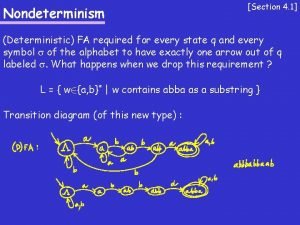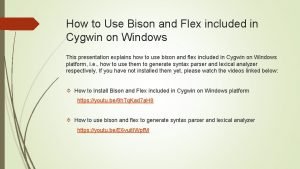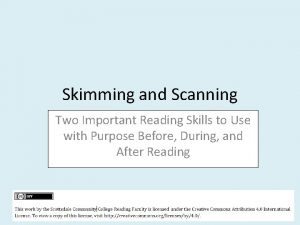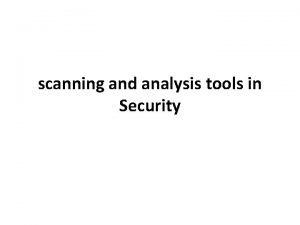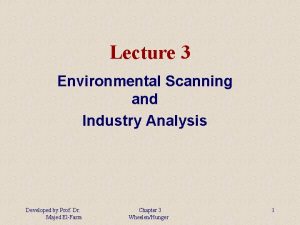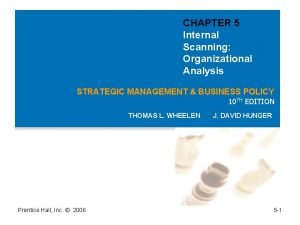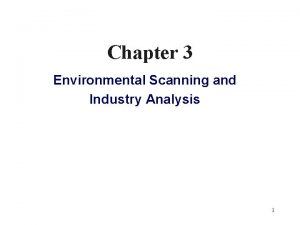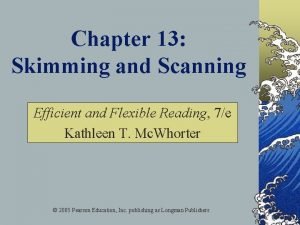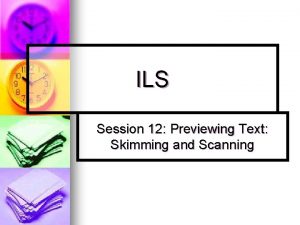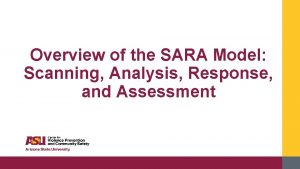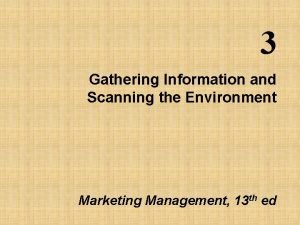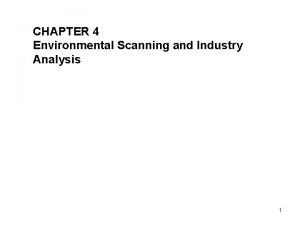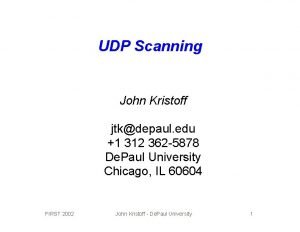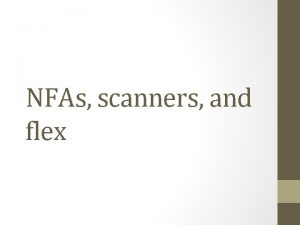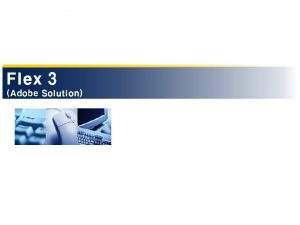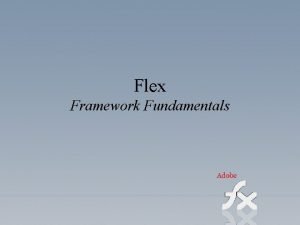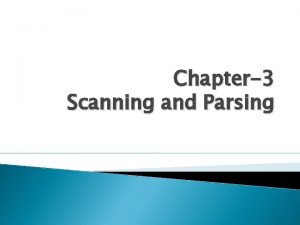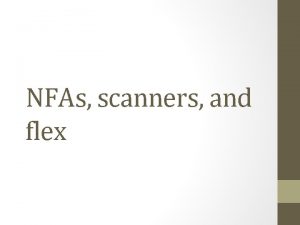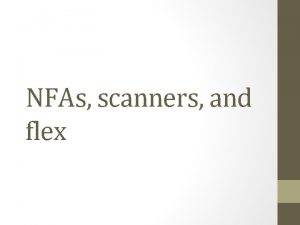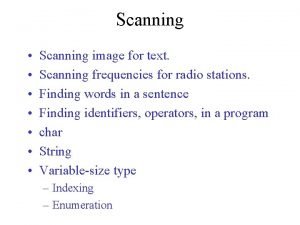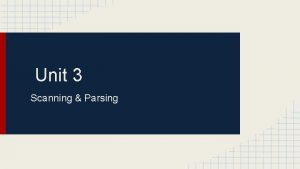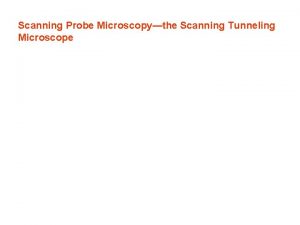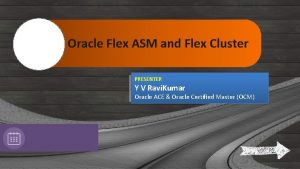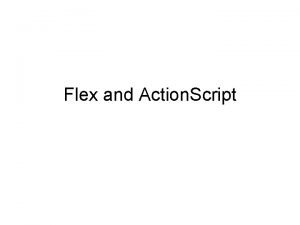More on scanning NFAs and Flex Last time
























![An example: decimals • Let d = [0 -9], then decimals are: d* (. An example: decimals • Let d = [0 -9], then decimals are: d* (.](https://slidetodoc.com/presentation_image/5b38c3c0b44d0eee26d06e3bcd137769/image-25.jpg)








- Slides: 33

More on scanning: NFAs and Flex

Last time • Scanners: the first step in compilation • Divides the program into tokens, or smallest meaningful units • This makes later parsing much simpler • Theory end of things: tokenizing is equivalent to specifying a DFA, which recognizes a regular language

Scanning • Recall scanner is responsible for • tokenizing source • removing comments • (often) dealing with pragmas (i. e. , significant comments) • saving text of identifiers, numbers, strings • saving source locations (file, line, column) for error messages Copyright © 2009 Elsevier

Scanning • Suppose we are building an ad-hoc (handwritten) scanner for Pascal: • We read the characters one at a time with look-ahead • If it is one of the one-character tokens { ( ) [ ] < > , ; = + - etc } we announce that token • If it is a. , we look at the next character • If that is a dot, we announce. • Otherwise, we announce. and reuse the lookahead Copyright © 2009 Elsevier

Scanning • If it is a <, we look at the next character • if that is a = we announce <= • otherwise, we announce < and reuse the lookahead, etc • If it is a letter, we keep reading letters and digits and maybe underscores until we can't anymore • then we check to see if it is a reserve word Copyright © 2009 Elsevier

Scanning • If it is a digit, we keep reading until we find a non-digit • if that is not a. we announce an integer • otherwise, we keep looking for a real number • if the character after the. is not a digit we announce an integer and reuse the. and the look-ahead Copyright © 2009 Elsevier

Scanning • Pictorial representation of a scanner for calculator tokens, in the form of a finite automaton Copyright © 2009 Elsevier

Regular expressions • A regular expression is defined (recursively) as: • A character • The empty string, ε • 2 regular expressions concatenated • 2 regular expressions connected by an “or”, usually written x | y • 0 or more copies of a regular expression – written *, and called the Kleene star

Regular languages • Regular languages are then the class of languages which can be described by a regular expression • Example: L = 0*10* • Another: L = (1|0)*

A more realistic example • Unsigned integers in Pascal: • Examples: 4, or 82. 3, or 5. 23 e-26 • Formally:

Another view: DFAs • Regular languages are also precisely the set of strings that can be accepted by a deterministic finite automata (DFA) • Formally, a DFA is: • a set of states • an input alphabet • a start state • a set of accept states • a transition function: given a state and input, outputs another state

DFAs • More often, we’ll just draw a picture (like in graph theory) • Example:

DFA examples • What’s the DFA for the regular language: 1(0|1)*0 • What’s the regular language accepted by this DFA?

Regular expression recap • Write a DFA that recognizes any 0, 1 string that has the number of 0’s in the string equal to 0 mod 3:

NFAs • Nondeterministic finite automata (NFA) are a variant of DFAs. • DFAs do not allow for any ambiguity: • if a character is read, there can only be 1 arrow showing where to go • No empty string transitions, so must read a character in order for the transition function to move to a new state • If instead we have multiple options, it is called an NFA

NFA Examples • What do the following NFAs accept?

More NFAs • Some things are easier with NFAs than DFAs: unsigned_number -> unsigned_int (ε |. unsigned_int) unsigned_int -> [0 -9]

NFAs • Essentially, when parsing a stream of characters, we can think of an NFA as modeling a parallel set of possibilities • Theorem: Every NFA has an equivalent DFA. • (And so both recognize regular languages, even though NFAs seem more powerful. )

Converting NFAs to DFAs • To convert, mimic set of possible states given an input • A state is an accept state if any state in it is an accept state – that means the string could have ended in an accept state, and so is in the language

Why do we care? • You may ask: why do we care about NFAs? • Well, in terms of defining a parser, we usually start with regular expressions. • We then need a DFA (since NFAs are harder to code). • However, getting from a regular expression to a DFA in one step is difficult. • Instead, programs convert to an NFA, and THEN to a DFA. • Somewhat un-intuitively, this winds up being easier to code.

Constructing NFAs • The construction process for NFAs is pretty easy. • Recall how a regular expression is defined: • A single character or ε • Concatenation • An “or” • Kleene star • So all we need to do is show to do each of these in an NFA (and how to combine them)

Constructing NFAs • Easy first step: What is the NFA for a single character, or for the empty string? • Now: what if I have NFAs for 2 regular expressions, and want to concatenate?

Constructing NFAs • A bit harder: what about an “or” or Kleene star?

Constructing NFAs • Final picture (2. 7 in book):
![An example decimals Let d 0 9 then decimals are d An example: decimals • Let d = [0 -9], then decimals are: d* (.](https://slidetodoc.com/presentation_image/5b38c3c0b44d0eee26d06e3bcd137769/image-25.jpg)
An example: decimals • Let d = [0 -9], then decimals are: d* (. d | d. ) d*

From NFAs to DFAs • Next, a scanning program needs to go from this NFA to a DFA • Mainly because “guessing” the right transition if there are multiple ones is really hard to code • Much easier to convert to DFA, even though it can get bigger. • (Side note: how much bigger? )

From NFAs to DFAs • If we automate this conversion on our last NFA (of decimals), we get:

Minimizing DFAs • In addition, scanners take this final DFA and minimize. • (We won’t do this part by hand – I just want you to know that the computer does it automatically, to speed things up later. )

Coding DFAs (scanners) • So, given a DFA, code can be implemented in 2 ways: • A bunch of if/switch/case statements • A table and driver • Both have merits, and are described further in the book. • We’ll mainly use the second route in homework, simply because there are many good tools out there.

Scanners • Writing a pure DFA as a set of nested case statements is a surprisingly useful programming technique • though it's often easier to use perl, awk, sed • for details see Figure 2. 11 • Table-driven DFA is what lex and scangen produce • lex (flex) in the form of C code – this will be an upcoming homework • scangen in the form of numeric tables and a separate driver (for details see Figure 2. 12)

Limitations of regular languages • Certain languages are simply NOT regular. • Example: Consider the language 0 n 1 n • How would you do a regular expression of DFA/NFA for this one?

Beyond regular expressions • Unfortunately, we need things that are stronger than regular expressions. • A simple example: we need to recognize nested expressions expr -> id | number | -expr | (expr)| expr op -> + | - | * | / • Regular expressions can’t quite manage this, since could do ((((x + 7) * 2) + 3) - 1)

Next time • Flex, a c-style scanner • Later this week: parsing and CFGs, which are stronger than DFAs/scanning
 Lirik lagu more more more we praise you
Lirik lagu more more more we praise you More more more i want more more more more we praise you
More more more i want more more more more we praise you Nfas are ___ dfas.
Nfas are ___ dfas. For minutes. start.
For minutes. start. Human history becomes more and more a race
Human history becomes more and more a race 5 apples in a basket riddle
5 apples in a basket riddle The more you study the more you learn
The more you study the more you learn Aspire not to have more but to be more
Aspire not to have more but to be more When dishes remain on a table when you yank
When dishes remain on a table when you yank Knowing more remembering more
Knowing more remembering more The more i give to thee the more i have
The more i give to thee the more i have More choices more chances
More choices more chances How to use bison
How to use bison Skimming and scanning quiz
Skimming and scanning quiz Scanning reading images
Scanning reading images What is skimming in communication
What is skimming in communication Skimming scanning exercises
Skimming scanning exercises Explain the tools of security analysis
Explain the tools of security analysis What is skimming technique
What is skimming technique Skim scan skip
Skim scan skip The corporation's societal environment
The corporation's societal environment Internal scanning
Internal scanning Environmental scanning and industry analysis
Environmental scanning and industry analysis What is overview skimming
What is overview skimming Gathering information and scanning the environment
Gathering information and scanning the environment Look through quickly
Look through quickly Previewing skimming and scanning
Previewing skimming and scanning Gathering information and scanning the environment
Gathering information and scanning the environment Sara model feedback
Sara model feedback Gathering information and scanning the environment
Gathering information and scanning the environment Scanning functional resources and capabilities
Scanning functional resources and capabilities The corporation's task environment
The corporation's task environment Gathering information and scanning the environment
Gathering information and scanning the environment Scanning and skimming examples
Scanning and skimming examples


